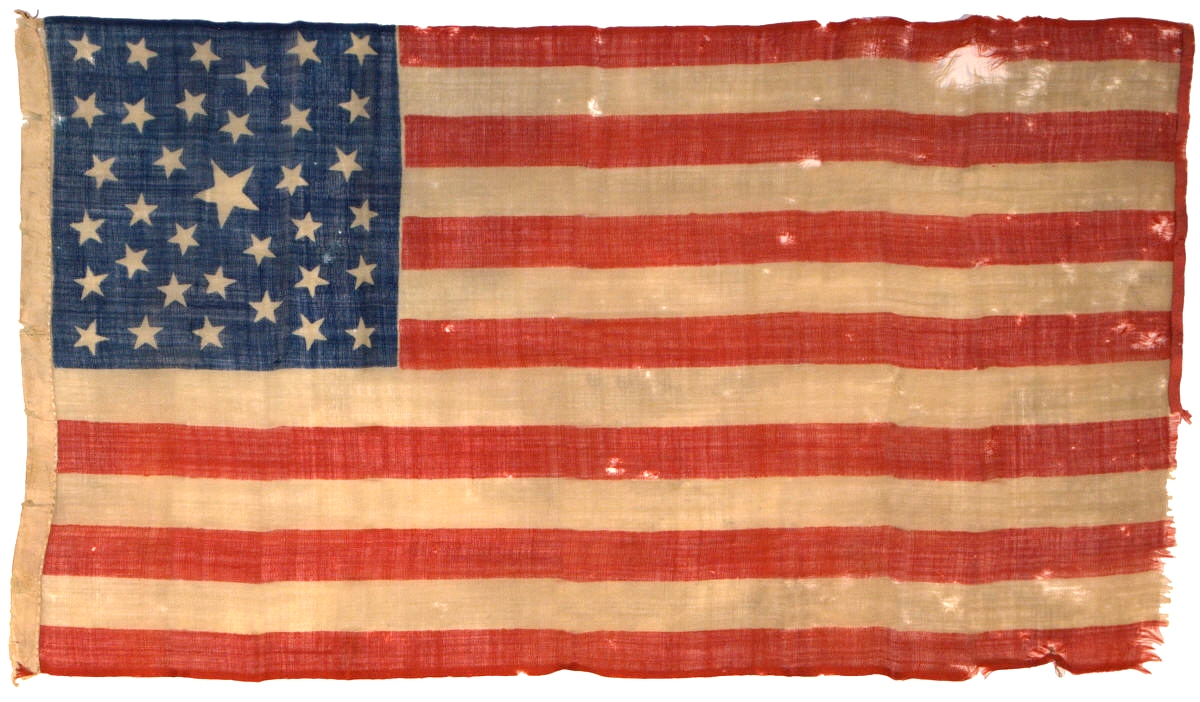|
 While
the star patterns of 19th century American flags can
vary greatly from the common modern convention of stars
in rows, among the rarest are those with random
placement and orientation of the stars. There are just a
small handful of pieced-and-sewn examples that exist,
and also a very few examples of printed flags with
random star patterns, such as this one. This particular
flag is one of just four or five examples of the type
known. A similar example of this type features 36 stars,
while the other handful of known examples features 35
stars like this flag. Rather than being printed on
cotton muslin like typical parade flags of the Civil War
era, these flags are printed on fine wool bunting, which
is made for prolonged use outdoors. Most, if not all, of
these kinds of press-dyed printed wool bunting flags
from the Civil War period were made for the purpose of
being used as a "Camp Color" which is the smallest
regulation flag carried and used during the war. While
these random-pattern wool flags are slightly longer than
the various Camp Color flags present in collections such
as the New York State Museum, it is also likely that
this flag and others like it were intended to be used as
Camp Colors. Camp Colors were flown on a staff outside
of the tent or quarters of a Union Army officer to
denote their presence in camp. This flag was found in
West Virginia, which was the 35th State, separating from
Virginia during he war and entering the Union as a free
state. A white silk strip was affixed to the hoist end
of the flag, and a red silk strip, now in part worn
away, was affixed to the fly end of the flag. It's clear
from the wear pattern of the flag that it was flown for
some period of time, but the colors of the flag are
beautiful and vibrant, with cream colored white stripes,
deep scarlet red stripes, and a rich indigo blue canton.
This is a fine example of a very scarce and beautiful
Civil War period flag. While
the star patterns of 19th century American flags can
vary greatly from the common modern convention of stars
in rows, among the rarest are those with random
placement and orientation of the stars. There are just a
small handful of pieced-and-sewn examples that exist,
and also a very few examples of printed flags with
random star patterns, such as this one. This particular
flag is one of just four or five examples of the type
known. A similar example of this type features 36 stars,
while the other handful of known examples features 35
stars like this flag. Rather than being printed on
cotton muslin like typical parade flags of the Civil War
era, these flags are printed on fine wool bunting, which
is made for prolonged use outdoors. Most, if not all, of
these kinds of press-dyed printed wool bunting flags
from the Civil War period were made for the purpose of
being used as a "Camp Color" which is the smallest
regulation flag carried and used during the war. While
these random-pattern wool flags are slightly longer than
the various Camp Color flags present in collections such
as the New York State Museum, it is also likely that
this flag and others like it were intended to be used as
Camp Colors. Camp Colors were flown on a staff outside
of the tent or quarters of a Union Army officer to
denote their presence in camp. This flag was found in
West Virginia, which was the 35th State, separating from
Virginia during he war and entering the Union as a free
state. A white silk strip was affixed to the hoist end
of the flag, and a red silk strip, now in part worn
away, was affixed to the fly end of the flag. It's clear
from the wear pattern of the flag that it was flown for
some period of time, but the colors of the flag are
beautiful and vibrant, with cream colored white stripes,
deep scarlet red stripes, and a rich indigo blue canton.
This is a fine example of a very scarce and beautiful
Civil War period flag.
|

